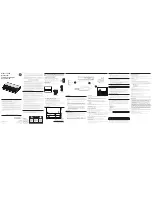
IP Configuration: RIPv2
How Rip Operates on the Device
337
Cisco 350, 350X and 550X Series Managed Switches, Firmware Release 2.4, ver 0.4
18
Filtering Routing Updates
You can filter incoming and outgoing routes for a given IP interface using two Standard
Access Lists - one for input and one for output.
The Standard Access List is a named, ordered list of pairs of IP prefix (IP address and IP mask
length) and action. The action can be deny or permit.
If an access list is defined, each route from the RIP message is checked against the list starting
from the first pair: if it matches the first pair and the action is permit, the route is passed; if the
action is deny, the route is not passed. If the route does not match, the following pair is
considered.
If there is no pair that the route matches, the deny action is applied.
Advertising Default Route Entries on IP Interfaces
The special address 0.0.0.0 is used for describing a default route. A default route is used to
avoid listing every possible network in the routing updates, when one or more closely-
connected routers in the system are prepared to transfer traffic to the networks that are not
listed explicitly. These routers create RIP entries for the address 0.0.0.0, just as if it a network
to which they are connected.
You can enable the default route advertisement and configure it with a given metric.
Redistribution Feature
The following type of routes exist and can be distributed by RIP:
•
Connected
—RIP routes that correspond to defined IP interfaces on which RIP is not
enabled (defined locally). By default, the RIP Routing Table only includes routes that
correspond to IP interfaces on which RIP is enabled.
•
Static
—Manually-defined (remote) routes.
You can determine whether static or connected routes are redistributed by RIP by configuring
the Redistribute Static Route or Redistribute Connected Route feature, respectively.
These feature are disabled by default and can be enabled globally.
If these features are enabled, rejected routes are advertised by routes with a metric of 16.
The route configurations can be propagated using one of the following options:
•
Default Metric
















































